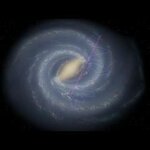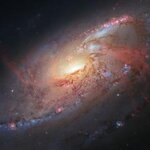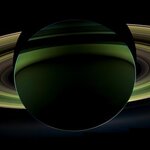Space

The expanding debris of exploded stars produces some of the fastest-moving matter in the universe, according to a new paper. Supernova remnants accelerate cosmic rays to incredible speeds.
Cosmic rays are subatomic particles that move through space at almost the speed of light. About 90 percent of them are protons, with the remainder consisting of electrons and atomic nuclei. In their journey across the galaxy, the electrically charged particles are deflected by magnetic fields. This scrambles their paths and makes it impossible to trace their origins directly. Through a variety of mechanisms…

Certain media sources have with the
announcement of a possible black hole 26,000 light years away at
W49B, mentioned the possibility of a wormhole. (I'm looking at you LA Times.) As a fan of many
sci-fi programs which featured some variety of wormhole, I would
welcome that. As a student of actual physics I don't think that such
a thing can exist based on everything we think we know about black
holes and quantum mechanics.
Classically black holes are regions of
space where gravity is so strong that space and time become twisted
beyond recognition. Effectively you “fall” into the black hole…

New data from NASA's Chandra X-ray Observatory suggest a highly distorted supernova remnant called W49B may contain the most recent black hole formed in the Milky Way galaxy.
W49B
appears to be the product of a rare explosion in which matter is ejected at high speeds along the poles of a rotating star and is about a thousand years old (as seen from Earth) and is located about 26,000 light-years away.
Usually when a massive star runs out of fuel, the central region of the star collapses, triggering a chain of events that quickly culminate in a supernova explosion. Most of these…

I have good news and bad news. The good news is that Asteroid 2012 DA14 is not going to hit Earth. The bad news is, even if it were going to hit Earth, it wouldn't happen until February 15th so you will still have to buy a Valentine's Day gift.
Asteroid 2012 DA14 was discovered last year, on February 22nd by astronomers at La Sagra Sky Survey observatory near Granada, Spain. Because it is small in size it was only noticed after it had flown past us, but astronomers knew then it would be back, this time much closer.
How close? 24,000 KM close. As in the distance of some satellites. That…

The Chinese Spring Festival or Chun Jie starts tomorrow 10th February. In case you are unfamiliar with the annual animals in the Chinese calendar we are now entering the year of the snake - 蛇 She ( water version). For most westerners the Spring Festival is known as the Chinese New Year.
I am quite certain that I will not shock you when I reveal that I have chosen celestial snakes as the topic of this Saturday in Space! I had such fun looking for snakes in space and in the occasion of the Chinese New Year I will in fact offer you more than one of the species. After all, it is THE most…

Before they go all-out supernova, some large stars undergo a sort of mini-explosion - cosmically speaking - which throws massive amounts of material into space. Though several models predict this behavior and evidence from supernovae point in that direction, observations of such pre-explosion outbursts are rare.
New research found such an outburst taking place a short time – just 40 days – before a massive star underwent a supernova explosion. The fact that they found such an outburst occurring just a little over a month before the onset of the supernova explosion was something of a surprise…

Up to six percent of red dwarf stars have habitable, Earth-sized planets. Red dwarfs are the most common stars in our galaxy, so that means the closest Earth-like planet could be just 13 light-years away.
Red dwarf stars are smaller, cooler, and fainter than our Sun. An average red dwarf is only one-third as large and one-thousandth as bright as the Sun. From Earth, no red dwarf is visible to the naked eye but we are surrounded by a swarm of red dwarf stars. About 75 percent of the closest stars are red dwarfs, and so, since 6 percent of those should host habitable planets, they arrived…

Messier 106 looks like lots of other galaxies yet it hides a number of secrets. But now, it has slightly fewer than before, thanks to citizen science astronomers.
The first mystery people always wonder about is the name. Messier 106 was neither discovered nor cataloged by the 18th century astronomer Charles Messier. It was instead discovered by his assistant, Pierre Méchain, but the galaxy was never added to the catalog in his lifetime either. Instead, along with six other objects discovered but not logged by either of them, Messier 106 was posthumously added to the Messier catalog in the…

Newly forming stars feed on huge amounts of gas and dust from dense envelopes surrounding them at birth and a team of astronomers reported observing an unusual "baby" star that periodically emits infrared light bursts, suggesting it may be a binary star.
The young object is called LRLL 54361, is about 100,000 years old and located about 950 light years away toward the Perseus constellation. Years of monitoring its infrared with the Spitzer instrument reveal that it becomes 10 times brighter every 25.34 days. This periodicity suggests that a companion to the central forming star is…

Saturn rocks! Or rather not, actually. The planet is made of gas for the most part, but it does have a belt of dust infested ice around it. It is this belt that makes Saturn the 'template' planet. If we want to draw a planet, it is much like a simplified Saturn. Strictly speaking it could also be the other gas planets but their rings are faint in comparison. Saturn is the archetype of a planet.
Saturn is the most stylish planet; none above, none by its side. I have
spent way too much time looking at the elegant images published by
NASA's programs in particular, but there are also some…